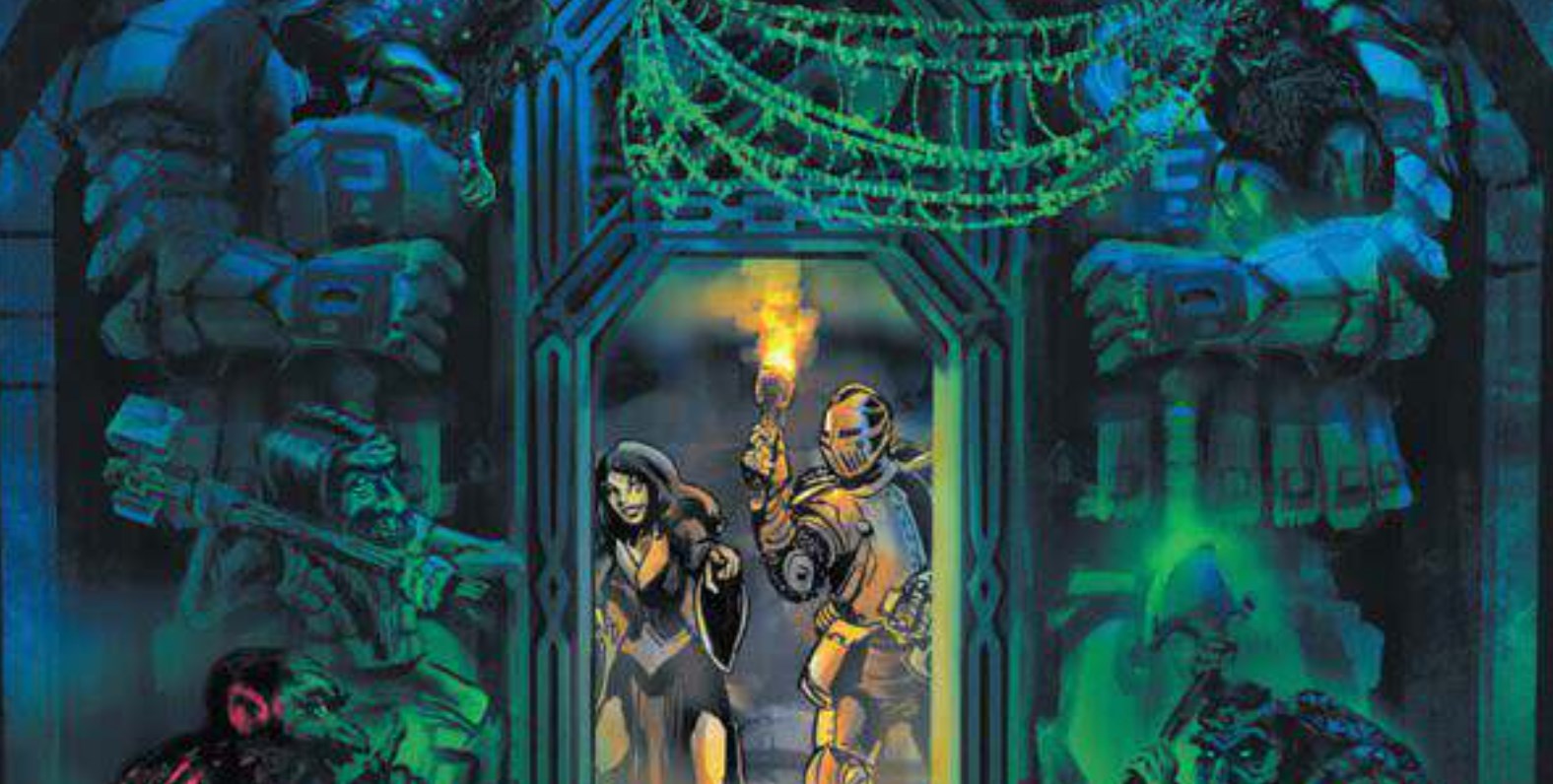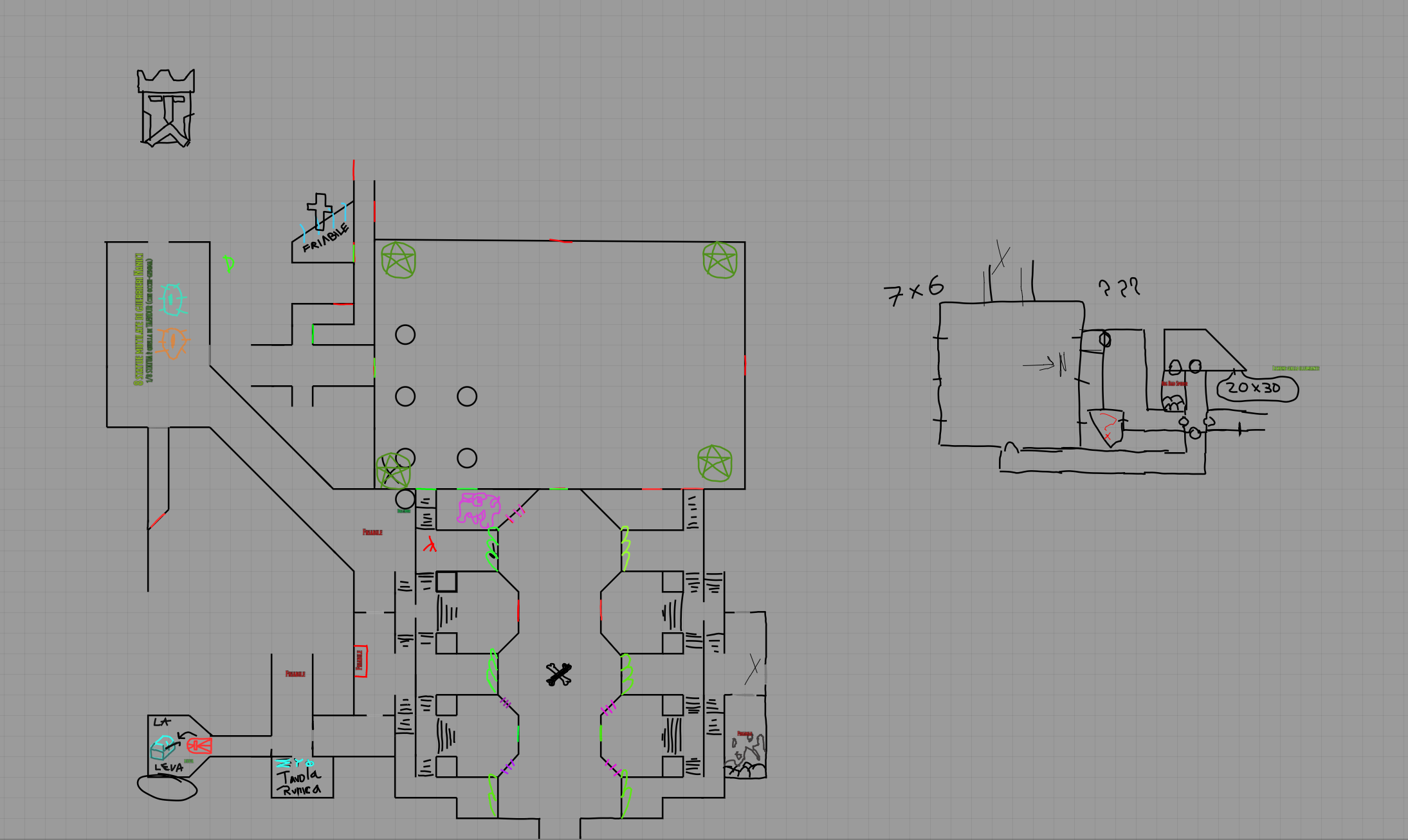Dwarrowdeep - Report And Review
07 Jul 2022A couple of days ago I started Dwarrowdeep. I’ve read through the whole book and played a couple of sessions with my players. This is a report of those two sessions and a “review” (in quotes since I didn’t play through the whole book) of the latest Gillespie’s module. If you don’t care about the play report feel free to skip to the end where you will find the review portion of the article.

The adventure started in Hamlet (Hommlet?) with 3 level one players: Tabudai (Magic-User), Eziochiele (Fighter) and Dargo van Myck (Thief). Hamlet is a small village in Gillespie’s fashion very similar to Helix from Barrowmaze. It’s inhabited by Dwarves fled from Dwarrowdeep when it was once a city, Humans and Cyclops, a curious addition. Hamelet has everything you’d expect from a starting village and base of operations: a tavern, shops, a main hall when dwarven leaders reside and a temple. It’s situated on a river, 15 miles from the dungeon and 30 miles from the nearest big city of Threshold. My players arrived and, eager to get to the dungeon didn’t spend much time here; it was also partially my fault since I didn’t flesh it out much in the first session (but we’ll get to this in the review part). After inquiring around about the location of the main entrance they swiftly left and reached the Doors of Dalgeddin safely.
They were prepared, and while carrying a torch and some mapping paper traversed the main gate and ventured into the darkness. The first few rooms were uneventful (a trend you’ll notice) and they slowly started to explore the main corridor and its western rooms. The exploration contiunued for roughly 40 minutes, but then it got interrupted by a random encounter: a warband! They were in the side rooms and the group of orcs slowly started to arrive from the main corridor, not paying too much attention towards being sneaky or secretive. This gave my players time to react and move away from the source of the noise to avoid getting spotted. Too bad this didn’t last long since their choice of corridors led them to a balcony overhanging the main area and the enemy warband immediately noticed the torch light and started running towards them.
A pursuit followed and my players ran north trying to hide in one of the smaller rooms facing the main hall. Unluckily this didn’t go as planned and they got spotted and had to fight. Tabudai cast a magic missile, Eziochiele tanked the hits and Dargo managed to land enough hits to kill them all. They got lucky but it was a small encounter, so they decided to continue. Heading west from the main hall they explored some more rooms and found themselves in one which north wall was frail and wet. Sadly they made the bad decision of investigating it, an action that made it crumble to stones prompting a saving throw from everyone: Eziochiele and Tabudai passed it, Dargo didn’t get so lucky and got hit for 6 damage, sadly enough to kill him. This was the last straw, damaged and with a lost companion they decided to leave the dungeon for a while. On the way out, while they were burying the corpse of Dargo they met a new face: Joe Belongi, a halfling who gave a big loan to an adventurer who ventured into Dwarrowdeep and never came back. He was, of course, our new character.

When they came back to Hamelet I started fleshing out the town and the tavern a bit more but it seemed like there wasn’t much interested in it. The group managed to hire three fighters: two humans and a dwarf, and after doing so they stayed in town for a while, healed their wounds and went back to Dwarrowdeep with the idea to explore more of the western part of the dungeon. That’s what they did, room after room, mapping and investigating. They found a locked chest and used a clever trick to open it getting some gems and money. Some of the ceilings were frail and they decided to avoid them, to not get killed like Dargo, and this erratic exploration led them to a room full of Stirges who flew into the corridor and started attacking and clinging themselves to the players. Tabudai and Eziochiele got hit really hard as they fought valorously, their blood getting drawn out of their body, but they survived and decided to call it a day once again.
Once again in Hamelet they sought the dwarves from the city since they had a dwarven tablet to sell, they met some in the main hall, sold the tablet and learned a bit more about the history of the dungeon. This was a short but sweet roleplaying moment, then they all went to sleep. They wanted more treasure but the dungeon wasn’t proving to be fruitful! The next day Eziochiele stayed in town, but the others ventured once more into the depths of the dwarven city.
This time they chose to go east, though their exploration was cut short by another random warband. This time, to avoid the previous mistake, they decided to run as fast as possible away from the main hallway (a bad idea, dare I say it). They crossed 5 or 6 rooms without the ability to map and found a place that seemed safe. They awaited for 20 minutes and then left trying to go back from where they came. This short segment of them not knowing where they were was pretty fun and interesting, as they tried to map the rooms they were in and connect back to a place they knew. Luckily (or unluckily ;)) they weren’t that far and managed to find the known areas pretty easily. During the exploration they opened one door which contained a Giant Crab spider which surprised them and once again they decided not to run. Joe got hit but passed his saving throw and then they killed the beast getting out of the fight almost unscathed. This was, howhever, too much for one day so they left the halls once again and returned to Hamlet.
Review
Welcome to Moria. In itself this shouldn’t be a bad thing but the first thing I noticed about Dwarrowdeep is how uninspired it was. The lore of the module is straight up a rip-off from Tolkien and the dwarves are the most classic dwarves you can imagine. Once again, being classic is not inherently bad, but as you might’ve noticed the play report wasn’t exactly exciting. I honestly didn’t skip many room descriptions, that’s all there was for the first 3 sessions (~9 hours of playtime). A lot of the rooms in the dungeon are empty, bland and forgettable: some monsters, a chest, a small trap. Most of the rooms also don’t have meaningful descriptions, which makes it hard piecing them together into a coherent narrative; except from the main hall and the other main areas all the other parts of the first dungeon feel completely random and placed in a way that wouldn’t make sense in something that was supposed to be a city.
I say first dungeon because Dwarrowdeep is structured in an interesting way, that I will concede: the whole “dungeon” is, in actuality, many miles big and covers many overword hexes. It is then subdivided into multiple smaller areas: entrances, primary areas and secondary areas. All these locations are then connected by tunnels (main, secondary, secret). All of the six entrances are keyed and mapped, although only two are accessible from the beginning. Primary areas are fully mapped and partially keyed: you as the DM will have to stock by yourself roughly 1/3rd of the rooms in them. Secondary areas are not keyed nor mapped and you will have to generate them by hand with the tools provided in the book.
The tunnels are chaotic and sprawling (a-la Veins Of Earth) and they require many hours of travel to be traversed. They might make for fun encounters and interesting situations, and I really like the idea of a dungeon that requires day to cross from start to end, thus making necessary the act of “conquering” it and building home bases inside. Too bad that all the passages and the connections have to be partially randomly generated as well: their slope, their length, how they start and end etc.
You can see where this is going. The tavern is randomly generated, warbands are randomly generated (It’s crazy, you have to roll for the type of warband, for the number of enemies, for their weapons, for their loot and for their goal; and if you get that they’re trading with another warband you have to do it all over again!), the loot is randomly generated, the prices of the runic tablets are randomly generated (based on what’s written there… Couldn’t Gillespie just give us the price for each tablet upfront…?), the magical effects of some items are also randomly generated.
The tools for generating everything seem solid enough, but one can’t help but feel like half of the book is missing, mainly because it’s not secondary content you’re generating but mandatory areas!
Other than that there are also other minor issues with the book: the editing is kind of poor and has quite a lot of mistakes, it references monsters from other Gillespie’s books without even quoting which book they’re from and the layout is confusing and it requires a lot of back and forth between pages.
The art is amazing as usual and there are some cool details about Hamelet, it’s inhabitats and religions (even though the whole Gazetteer seems a copy-paste from Barrowmaze), but that looks like it’s about it. The main value one can get from the book is its scope, not its content. As far as I’ve read there’s nothing really unique, but there’s a lot of stuff, so if you think it’s worth the hefty price of the book then go ahead and buy it, otherwhise consider generating your own megadungeon with the tools provided in the AD&D appendix ;)
No comments
Comments are closed